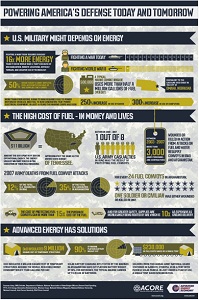AEE, ACORE working with DOD to help it get clean
 Advanced Energy Economy (AEE) and American Council on Renewable Energy (ACORE) held the first of a series of forums Jan. 25 with the Department of Defense (DOD) to help the world’s biggest energy user get more of its power from renewables. This year they will hold a series of forums to address how companies and DOD can work together to help the department reduce its dependence on fossil fuels both in the U.S. and in overseas operations.
Advanced Energy Economy (AEE) and American Council on Renewable Energy (ACORE) held the first of a series of forums Jan. 25 with the Department of Defense (DOD) to help the world’s biggest energy user get more of its power from renewables. This year they will hold a series of forums to address how companies and DOD can work together to help the department reduce its dependence on fossil fuels both in the U.S. and in overseas operations.
There’s big opportunity there.
Consider this: In 2010, the DOD consumed 125 million barrels of oil in fiscal year 2010. That’s more than what was used by 82 percent of the world's countries individually, according to ACORE and AEE. And the DOD projects its fuel and electric will cost $150 billion over the next decade, and as taxpayers, that’s your bill, too.
The forums are designed to help reduce those costs, providing the military with access to renewable energy that can reduce its energy costs and save lives in forward operating bases and combat situations.
“It’s not about green. It’s all about the fact of mission security. It’s all about energy security,” said Nick d'Arbeloff, president of Regional Development and National Programs at ACORE.
It’s a two-part proposition, according to retired Admiral Dennis McGinn, president and CEO of ACORE.
“On one hand the renewable energy sector needs to know a lot more about where the DOD is going [with energy use],” he said.
On the other hand, he said, companies need to help the DOD understand what technical and financial instruments are available to accelerate adoption of renewable energy.
The military’s current dependence on fossil fuels has a human cost as well, according to d'Arbeloff.
Using convoys to move fuel to forward-operating bases and missions costs lives. For instance, 12 percent of Army casualties in Iraq and 35 percent of casualties in Afghanistan in 2007 were because fuel convoys were attacked. Convoys themselves add significant costs to fuel, making a gallon of diesel delivered to front lines cost more than $10.
The generators on the front lines can also harm troops, McGinn said. He recounted a story of how some Marines in a tough firefight were surprised to find after the fight was over that their PV array, though damaged was still producing power. If they’d had a diesel generator that was damaged in the fight, it could easily have injured the soldiers and been inoperable, making them more vulnerable, he said.
Using more renewable energy across all of the DOD’s operations could also help it save money and better plan its monetary resources, since energy will become more of a fixed cost than a wildly fluctuating one, like oil.
“At the beginning of the recession oil went from $40 a barrel to $107 a barrel,” McGinn said. The military had to pay for the unexpected price increase using readiness money—which also is used for armor, weapons and other uses.
“It’s an unstable situation, he said. “The price of oil will be volatile and will go up.”
If the cost of a barrel of oil goes up by $10, that’s an increase of $1.2 billion in spending over a year.
The military is really good at looking over the horizon and identifying risks, managing them, and mitigating them in some way, McGinn said. But those risks don’t have to include wildly swinging energy costs.
The forums ACORE and AEE are holding will help the department and private sector find ways to mitigate those risks.
Click here for a more detailed view of the infographic above.



